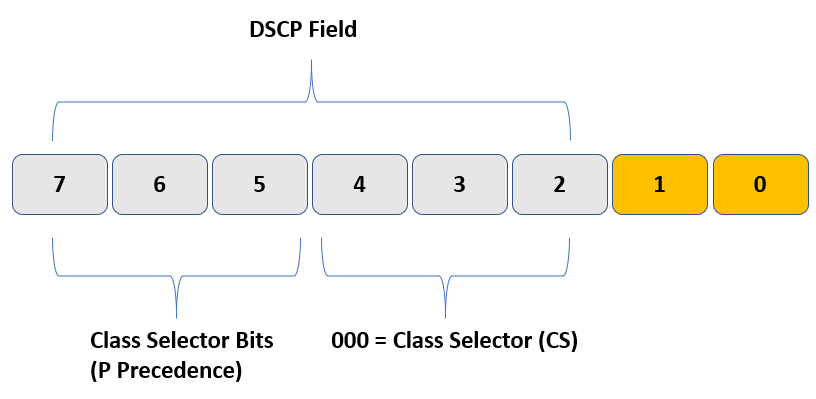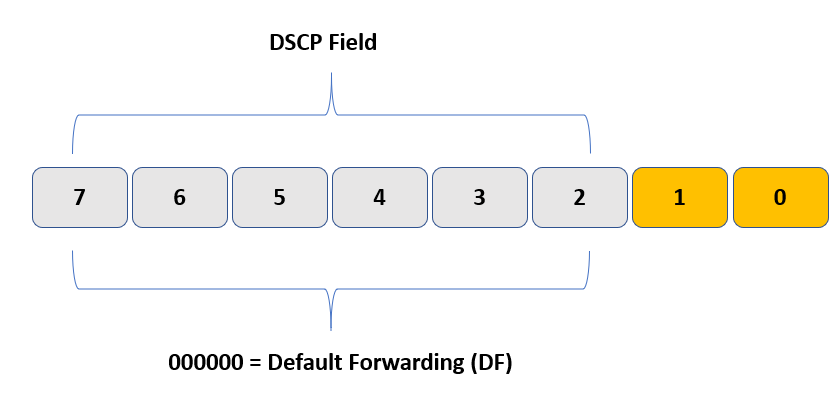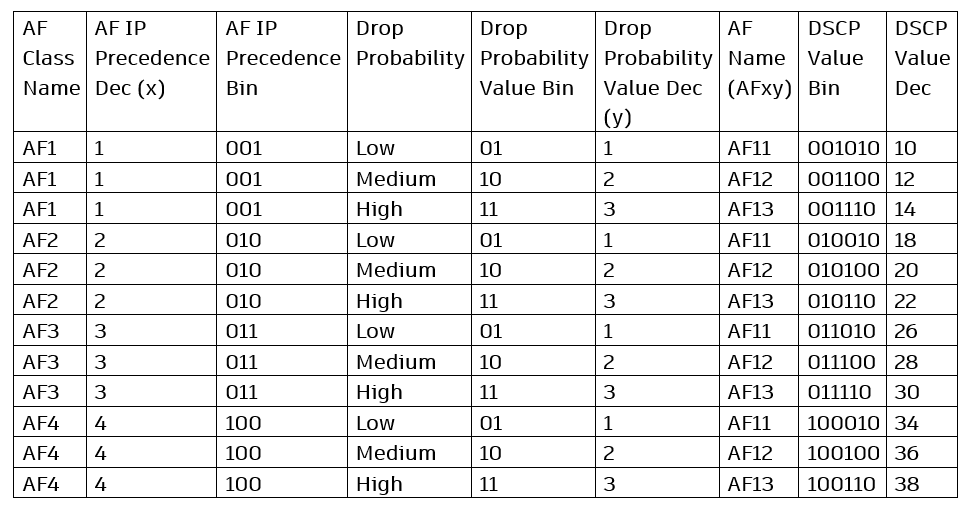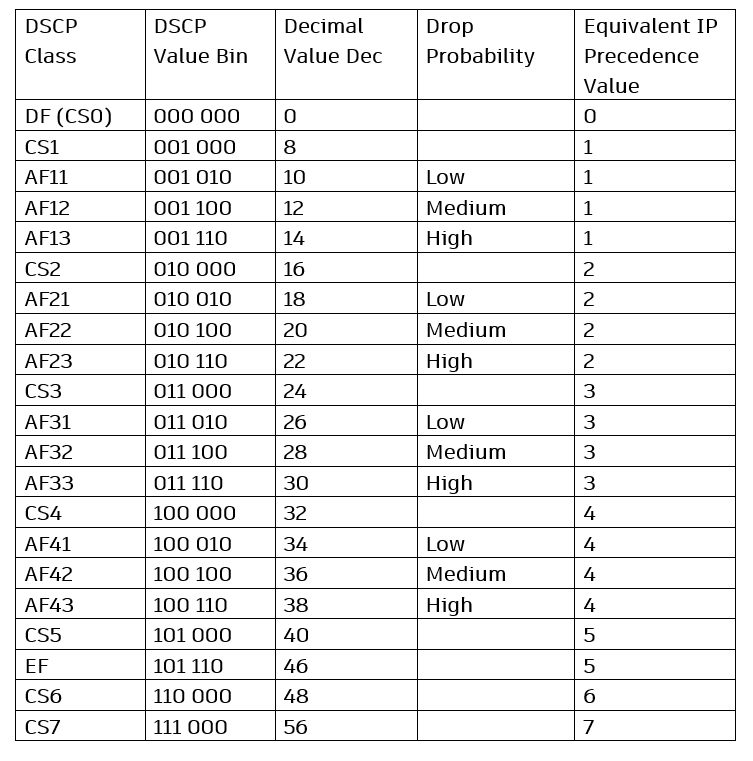DSCP Marking packets are classified and marked to receive a particular per-hop forwarding behavior (that is, expedited, delayed, or dropped) on network nodes along their path to the destination. The DiffServ field is used to mark packets according to their classification into DiffServ Behavior Aggregates (BAs). A DiffServ BA is a collection of packets with the same DiffServ value crossing a link in a particular direction. Per-hop behavior (PHB) is the externally observable forwarding behavior (forwarding treatment) applied at a DiffServ-compliant node to a collection of packets with the same DiffServ value crossing a link in a particular direction (DiffServ BA).
In other words, PHB is expediting, delaying, or dropping a collection of packets by one or multiple QoS mechanisms on a per-hop basis, based on the DSCP value. A DiffServ BA could be multiple applications—for example, SSH, Telnet, and SNMP all aggregated together and marked with the same DSCP marking value. This way, the core of the network performs only simple PHB, based on DiffServ BAs, while the network edge performs classification, marking, policing, and shaping operations. This makes the DiffServ QoS model very scalable.
Four PHBs have been defined and characterized:
- Class Selector (CS) PHB
- The CS bits are the first three bits of the DSCP field. Because IP Precedence utilizes the same three bits to identify class, the CS bits make DSCP backward compatible.
- Default Forwarding (DF) PHB
- When providing a best-effort service, this term is used.
- Assured Forwarding (AF) PHB
- Used to provide assured bandwidth.
- Used to provide assured bandwidth.
- Low-delay service is provided by this method.
DSCP Marking Class Selector (CS) PHB
Packets with higher IP Precedence should be forwarded in less time than packets with lower IP Precedence.
The last 3 bits of the DSCP (bits 2 to 4), when set to 0, identify a Class Selector PHB, but the Class Selector bits 5 to 7 are the ones where IP Precedence is set. Bits 2 to 4 are ignored by non-DiffServ-compliant devices performing classification based on IP Precedence.
There are eight CS classes, ranging from CS0 to CS7, that correspond directly with the eight IP Precedence values.

Default Forwarding (DF) PHB
Default Forwarding (DF) and Class Selector 0 (CS0) employ the DS value 000000 to achieve best-effort functionality.

Default best-effort forwarding is also applied to packets that cannot be classified by a QoS mechanism such as queueing, shaping, or policing. This usually happens when a QoS policy on the node is incomplete or when DSCP values are outside the ones that have been defined for the CS, AF, and EF PHBs
Assured Forwarding (AF) PHB
An AF class is guaranteed a set amount of bandwidth by the AF PHB, and further bandwidth is accessible if it is available. DSCP marking structure for packets needing AF PHB is aaadd0, where aaa is the binary value of the AF class (bits 5–7) and dd (bits 2–4) is the drop probability, with bit 2 being unused and always set to 0.

There are four standard-defined AF classes: AF1, AF2, AF3, and AF4. The AF class number does not represent precedence; for example, AF4 does not get any preferential treatment over AF1. Each class should be treated independently and placed into different queues.
The table below illustrates how each AF class is assigned an IP Precedence (under AF Class Value Bin) and has three drop probabilities: low, medium, and high. The AF Name (AFxy) is composed of the AF IP Precedence value in decimal (x) and the Drop Probability value in decimal (y). For example, AF41 is a combination of IP Precedence 4 and Drop Probability 1. To quickly convert the AF Name into a DSCP value in decimal, use the formula 8x + 2y. For example, the DSCP value for AF41 is 8(4) + 2(1) = 34.
AF PHBs with Decimal and Binary Equivalents

An AF implementation must detect and respond to long-term congestion within each class by dropping packets using a congestion-avoidance algorithm such as weighted random early detection (WRED). WRED uses the AF Drop Probability value within each class—where 1 is the lowest possible value, and 3 is the highest possible—to determine which packets should be dropped first during periods of congestion. It should also be able to handle short-term congestion resulting from bursts if each class is placed in a separate queue, using a queueing algorithm such as class-based weighted fair queueing (CBWFQ). The AF specification does not define the use of any particular algorithms to use for queueing and congestion avoidance, but it does specify the requirements and properties of such algorithms.
Expedited Forwarding (EF) PHB
The EF PHB can be used to build a low-loss, low-latency, low-jitter, assured bandwidth, and end-to-end service. The EF PHB guarantees bandwidth by ensuring a minimum departure rate and provides the lowest possible delay to delay-sensitive applications by implementing low-latency queueing. It also prevents the starvation of other applications or classes that are not using the EF PHB by policing EF traffic when congestion occurs.
Packets requiring EF should be marked with DSCP marking binary value 101110 (46 in decimal). Bits 5 to 7 (101) of the EF DSCP value map directly to IP Precedence 5 for backward compatibility with non-DiffServ-compliant devices. IP Precedence 5 is the highest user-definable IP Precedence value and is used for real-time delay-sensitive traffic (such as VoIP). Table 14-4 includes all the DSCP PHBs (DF, CS, AF, and EF) with their decimal and binary equivalents. This table can also be used to see which IP Precedence value corresponds to each PHB.
DSCP Marking PHBs with Decimal and Binary Equivalents and IPP

Scavenger Class
The scavenger class is intended to provide less-than-best-effort services. Applications assigned to the scavenger class have little or no contribution to the business objectives of an organization and are typically entertainment-related applications. These include peer-to-peer applications (such as Torrent), gaming applications (for example, Minecraft, and Fortnite), and entertainment video applications (for example, YouTube, Vimeo, Netflix). These types of applications are usually heavily rate-limited or blocked entirely.
Something very peculiar about the scavenger class is that it is intended to be lower in priority than a best-effort service. Best-effort traffic uses a DF PHB with a DSCP value of 000000 (CS0). Since there are no negative DSCP values, it was decided to use CS1 as the marking for scavenger traffic. This is defined in RFC 4594.
Download our Free CCNA Study Guide PDF for complete notes on all the CCNA 200-301 exam topics in one book.
We recommend the Cisco CCNA Gold Bootcamp as your main CCNA training course. It’s the highest rated Cisco course online with an average rating of 4.8 from over 30,000 public reviews and is the gold standard in CCNA training:
